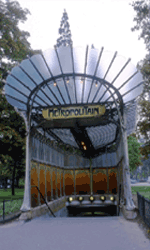HISTORY OF THE METRO

©
Paris Tourist Office -
Photographe : Catherine Balet
Different stations even bore the same name on the two different lines, there were two stations called Grenelle, for example)

©Paris Tourist Office -
Photographe : Catherine Balet
It was all the way to 15th October 1998 before another new
line was opened: the 14, initially running from Madeleine
and to the
National Library, then extended to cover
gare Saint-Lazare. The 14 is a modern automated line, considerably
reducing waiting time. It is also the line that serves as a
demonstration model for RATP
and the manufacturer, Alstom.
Previously, another line had carried the number 14: this was
the southern part of what is now line 13 (south of Invalides).
At that time, line 13 had its terminus at Saint Lazare and the
two sections between Saint Lazare and Invalides were joined
in the 1970’s. It was proposed that the unlucky number
13 should be deleted from the network, in the same way that
it is not used in aeroplanes or hotels, but in the case of the
metro, the idea didn’t stick. The carriages of line 13
were originally unique (but later adopted on lines 7 and 8),
having been designed taking into account the suggestions of
passengers, a notable difference is the softness of the lighting
in these carriages.
Despite the fact that the highest numbered metro is the 14, there are in fact sixteen lines. This resulted from the splitting of lines 3 and 7 (in 1971 and 1967 respectively), which necessitated the creation of the short lines 3bis and 7bis.
The Paris metro is principally run by RATP, which also manages the city’s buses and tramways and partly manages the RER (Réseau Express Régional) in Paris.
- Paris-city Partners :
- Music News
- Rock, Jazz & Blues CDs
- Learn French in Paris
- Learn French in France
- Paris Junior Programs
- Learn English in England
- Business English Courses
- Need a translation?
- For teachers of French
- French Exercise & Tests
- Directories
- English courses for Teens in UK
- Camps for Teens in England
- Language Courses Abroad
- English courses in England
- Learn a Language Abroad


